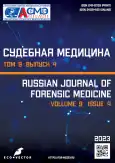Establishment of the morphological features of stab injuries to the ribs caused by a knife with a blade spine thickness of 0.1 cm
- Authors: Potankina T.V.1,2, Maksimov A.V.2,3, Lysenko O.V.1,2, Kislov M.A.4
-
Affiliations:
- Bureau of Forensic Medical Examination
- Moscow Regional Research and Clinical Institute
- State University of Education
- Pirogov Russian National Research Medical University (Pirogov Medical University)
- Issue: Vol 9, No 4 (2023)
- Pages: 421-428
- Section: Original study articles
- URL: https://journals.rcsi.science/2411-8729/article/view/251336
- DOI: https://doi.org/10.17816/fm15723
- ID: 251336
Cite item
Full Text
Abstract
BACKGROUND: The identification of all possible parameters and features of the tool that caused the injuries is of high significance for resolving specific forensic questions in the study of stab injuries to the ribs. However, data on the influence of blade spine thickness on the morphological features of stab injuries to the ribs are lacking.
AIM: To determine the morphological features of stab injuries caused by a knife with a blade spine thickness of 0.1 cm at various angles of impact relative to the lamellar structure of the rib.
MATERIALS AND METHODS: Experimental works were performed. Injuries were inflicted perpendicularly to the plane of the rib, to a depth of 5.4 cm, with a knife having a blade spine thickness at the penetration level of 0.1 cm. The study analyzed the anterior sections of ribs IV–VI of individuals of both sexes, predominantly male, aged 18–59 years, which is based on an experimental literature review of cutting and stubbing injuries. In total, 60 experiments were conducted, with 20 injuries each inflicted longitudinally, obliquely, and transversely on the rib lamellar structure. The results of the macroscopic observations were recorded and considered for subsequent interpretation.
RESULTS: In the macroscopic examination of injuries inflicted at various angles to the lines of the compact layer’s lamellar structure, linear-slit-shaped injuries were registered on the external compact plate. When oriented longitudinally in relation to the long axis of the bone, arcuate slit-shaped injuries were also observed. When a split crack was formed in the blade spine zone, a crack formed from one of the corners of the blunt end of the injury, extending longitudinally and obliquely along the bone’s lamellar structure, with some deviations toward the edge of the bone nearest to the injury. In transverse alignment of the injury to the long axis of the bone, the split crack morphologically corresponded to a fracture in bending deformation, gravitating toward the rib edge. The area influenced by the blade spine showed no macroscopic signs of abrasion of the compact or spongy bone. The blunt end of the injury had a round shape. On the internal compact plate, the shape of the injuries more frequently appeared slit-like, and in some cases serrated, due to the bulging of compact bone areas.
CONCLUSION: The study identified significant specific morphological features of stab injuries to the ribs caused by a knife with a blade spine thickness of 0.1 cm, taking into account the lamellar structure of the bone tissue, which allows us to draw conclusions about the knife blade spine thickness.
Full Text
##article.viewOnOriginalSite##About the authors
Tatiana V. Potankina
Bureau of Forensic Medical Examination; Moscow Regional Research and Clinical Institute
Email: tatiana.potankina@mail.ru
ORCID iD: 0000-0001-5768-6187
SPIN-code: 1537-8310
Russian Federation, Moscow; Moscow
Aleksandr V. Maksimov
Moscow Regional Research and Clinical Institute; State University of Education
Author for correspondence.
Email: mcsim2002@mail.ru
ORCID iD: 0000-0003-1936-4448
SPIN-code: 3134-8457
MD, Dr. Sci. (Med.), Assistant Professor
Russian Federation, Moscow; MoscowOleg V. Lysenko
Bureau of Forensic Medical Examination; Moscow Regional Research and Clinical Institute
Email: lysenkooleg1@yandex.ru
ORCID iD: 0000-0003-1802-2331
SPIN-code: 2396-6072
MD, Cand. Sci. (Med.), Assistant Professor
Russian Federation, Moscow; MoscowMaksim A. Kislov
Pirogov Russian National Research Medical University (Pirogov Medical University)
Email: smedik@gmail.com
ORCID iD: 0000-0002-9303-7640
SPIN-code: 3620-8930
MD, Dr. Sci. (Med.), Professor
Russian Federation, MoscowReferences
- Kislov MA. Morphology and mechanics of bone tissue destruction under the action of stabbing and cutting implements. stabbing-cutting implements: 14.03.05; Moscow State Medical and Dental University named after A.I. Evdokimov [dissertation abstract]. Moscow; 2016. 36 p. (In Russ).
- Korshenko DM. Forensic medical evaluation of the sharpness of the ribs of the shoe of a stabbing and cutting object: 14.03.05; Russian Center of forensic-medical expertise of the Ministry of Health of the Russian Federation [dissertation abstract]. Moscow; 2011. 23 p. (In Russ).
- Krupin KN. Forensic evaluation of the morphology of stab wounds formed by knife blades with various defects of the point: 14.03.05; Russian Center of forensic-medical expertise of the Ministry of Health of the Russian Federation [dissertation abstract]. Moscow; 2015. 23 p. (In Russ).
- Leonov SV. Differential diagnostics of chopped injuries of skin and flat bones of a skull on the sign of sharpness of a blade: 14.00.24; Russian Center of forensic-medical expertise of the Ministry of Health of the Russian Federation [dissertation abstract]. Moscow; 2007. 23 p. (In Russ).
- Kislov MA. Identification of piercing and cutting weapons in case of flat bones damage. Ekspert-kriminalist. 2016;(2):6–9.
- Potankina TV, Lysenko OV, Klevno VA. Perspectives of the study of cutting and stabbing damages caused by knives with various spine thicknesses. Russ J Forensic Med. 2022;8(4):67–75. doi: 10.17816/fm696
Supplementary files










